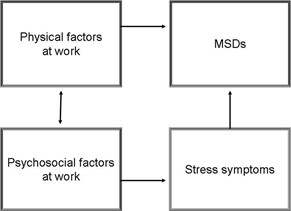Written by Ergonomic & Safety Consultant Matthew Culloty
Very often the ergonomic risk assessment identifies the physical risk factors of a task or working environment and how this can negatively affect the individual, such as lower back pain, forearm discomfort or visual strain etc. Only in the last decade have mental health issues really come to the foremind of companies. More and more are taking a proactive approach to employee wellbeing, investing in mental health awareness and mental health first aiders, but it is often viewed as a separate entity to the physical risks factors.

Psychosocial Factors are essentially how the physical and mental factors overlap and are closely linked. They can be influenced negatively or positively in the working environment and organisational structure depending on the circumstances. A good psychosocial environment enhances good performance and personal development, as well as workers’ mental and physical well-being.
Common psychosocial stressors can be:
- High frequent workloads
- Lack of control over the work (monotonous)
- Lack of role clarity and organisation support.
- Poor organisational management and communication.
- Job security.
- cognitive overload or limited mental stimuli in the job.
From a government level we see recent changes to hopefully facilitate these psychosocial factors to reduce the ‘always on’ perception and set guidance for a structured work life balance in the ‘right to disconnect’. With reports of a shorter work week being trialled, will this have unintended consequences of cramming more work into a shorter time frame leading to additional stressors? Or will it allow business to identify how systems can be improved for efficiency and productivity while maintaining a healthy workforce?
Much like how this pandemic has forced us to think differently in the future of work and what ‘can’t’ be achieved…. until it can.
Digital technologies and new forms of work represent opportunities and challenges for companies and workers. While this offers huge potential in greater flexibility and autonomy for the remote worker or less physical strain due to automation onsite, this can also create sources of stressors by isolation or more scrutiny on the remote worker or result in less worker engagement on a role that is machine dictated.
Has your company identified in their home working policy how these factors can be reduced?
Are these factors considered and assessed in the job/task design?
If you require further information or assistance please contact us via email at info@cmse.ie, by phone at 021 497 8100 or start an instant chat with us via the chat box in the bottom right-hand corner of your screen.
